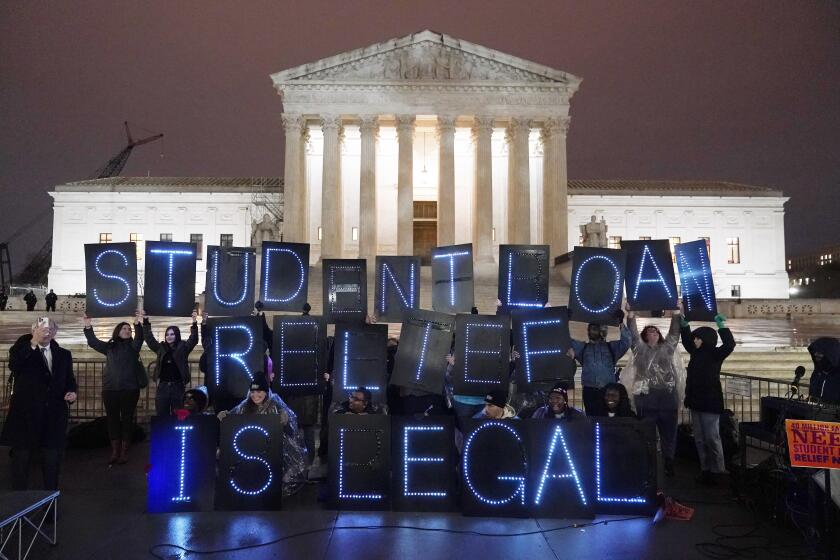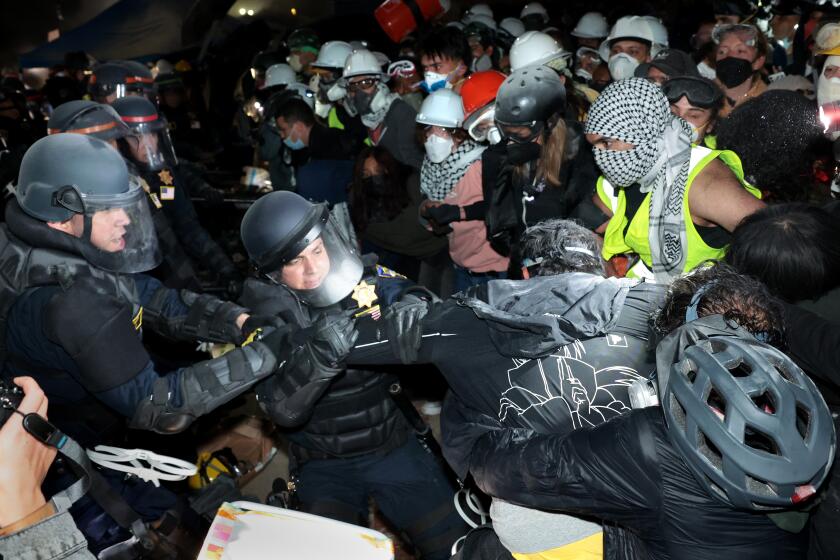Expulsion Referrals in L.A. District Rise 28% Over 5 Years : Schools: Officials say weapons possession was the main reason for the recommendations. Many students are placed in alternative programs.
The number of students recommended for expulsion in the Los Angeles Unified School District rose 28% over the last five school years, with weapons the primary reason for such referrals, according to district reports.
In 1990-91, 889 students faced expulsion for offenses ranging from carrying weapons to vandalizing school property, compared to 696 in 1986-87. From guns to Mace, weapons carried by students on or near campus accounted for about half of the offenses that resulted in recommendations for expulsion in the last school year alone, according to the most recent summaries compiled by the district. Over a five-year period, weapons-related referrals rose 57%, to 519 in 1990-91, from 330 in 1986-87.
Of the 889 students referred for expulsion during the last school year, 76 were forced to leave school, while 560 were referred to such alternatives as continuation schools, independent study programs and adult employment preparation centers. Students given the alternative placements are still considered expelled. District officials could not say what punishment was meted out specifically to students caught with weapons.
County and district officials emphasized that the increasing number of weapons-related referrals may have as much to do with stricter enforcement of district policy as it does with an increasing presence of weapons on campus.
“At (school) board direction, weapons--not just guns but a pocket knife--(became) a reportable offense, so naturally our statistics are going to increase,” Deputy Supt. Ruben Zacarias said in an interview Monday.
Hector Madrigal, coordinator of the district’s student discipline proceedings, added that greater vigilance on the part of administrators and students may also be leading to heightened reporting of incidents. “It could be the fact everyone is more conscious of the problem,” Madrigal said. “Consequently detection of weapons is more likely to occur when it’s on officials’ and students’ minds.”
But Madrigal, Zacarias and other education officials agreed that the number of weapons on campuses apparently is on the rise because more students feel they need protection on their way to and from school.
“There’s been an increase in weapons reported on campuses across the county,” said Phil Kauble, consultant in charge of attendance and administrative services for the Los Angeles County Office of Education. “In those areas where you seem to have gang problems and issues leading to student fear, then you’re going to find students carrying more weapons.”
Zacarias said the increase “is not limited along socioeconomic or racial lines. It cuts across the entire spectrum. It’s an unfortunate sign of the times.”
During the last school year, 845 guns and knives were taken from students on or near campuses, according to Madrigal. The state education code requires that a principal recommend expulsion for a student found with a weapon, unless the administrator can cite reasons expulsion would not be appropriate.
If the principal does recommend expulsion, the student is entitled to an investigation and hearing before a district expulsion review committee, which includes a school counselor and a psychologist. After investigating the incident, the committee decides whether the student has violated the state education code, and if so, makes recommendations as to punishment.
A policy change approved by the Los Angeles Board of Education in 1990 required the committee to recommend expulsion for any student found guilty of possessing a firearm, or to have attacked other students or staff members. However, the board had final say in whether the child should be barred from district schools or allowed to attend an alternative educational program.
The policy was modified last September to allow the committee to recommend alternative placement rather than straight expulsion for students younger than 16. The school board retains final say.
Board member Mark Slavkin said it remains a constant debate among board representatives as to whether students found guilty of carrying weapons on campus should be allowed to attend any educational program in the district.
“I’ve supported all along a very strict policy that says possession of a gun is cause for straight expulsions from the school district,” said Slavkin. “When you water down that policy and allow kids with guns to be referred to some other program in the district . . . you’ve lost the force of that threat, of that message.”
But board President Warren Furutani disagreed with a straight expulsion policy, noting that many of the offenders are in junior high school.
“At first blush it’s easy to say you expel them onto the street,” said Furutani. “My problem is what happens when they’re on the street? I’m not ready to throw my hands up. I’m not ready to have them in a regular school by any means, but having them on the street unsupervised to me is not the answer.”
Reports show that 58% of the weapons-related referrals last school year involved students in sixth through eighth grades.
Expulsions, which bar students from any educational facility in the district, last the balance of the semester in which the offense occurred, plus the following academic term, Madrigal said. Students who are allowed to attend an alternative site do so for one calendar year.
The rise in overall expulsion referrals between 1986-87 and 1990-91 greatly outstripped the 4% growth of the district’s enrollment over the same period. But Linda Wilson, coordinating counselor for student discipline proceedings, noted that the students who faced expulsion in the last school year represented only a fraction of the district’s more than 600,000 students.
Zacarias said district policies that virtually ensure some type of punishment for carrying a weapon on campus serve as a deterrent to many students.
District reports also showed a 66% increase in assault-related expulsion referrals over a five-year period.
But there were also dramatic decreases. The expulsion referrals for students caught with controlled substances dropped 23% during the five-year stretch, and 14% in 1990-91 from the previous year’s total of 211. Referrals for vandalism of school property showed a steeper decline of 71%, dropping from 84 incidents in 1989-90 to 24 incidents in 1990-91.
More to Read
Sign up for Essential California
The most important California stories and recommendations in your inbox every morning.
You may occasionally receive promotional content from the Los Angeles Times.






